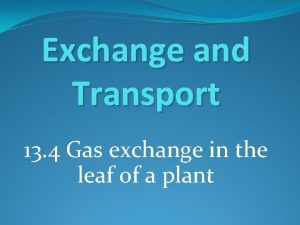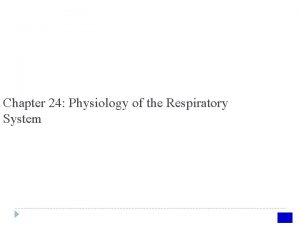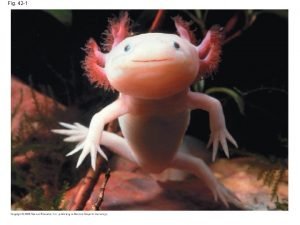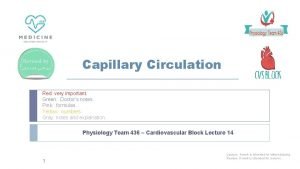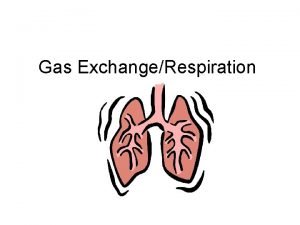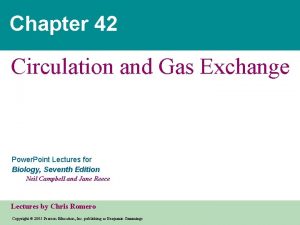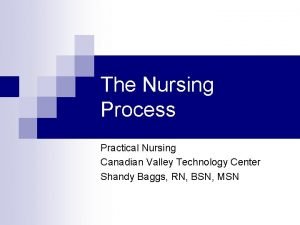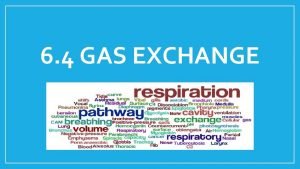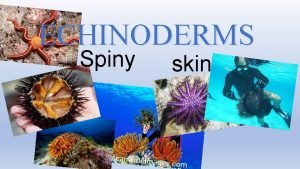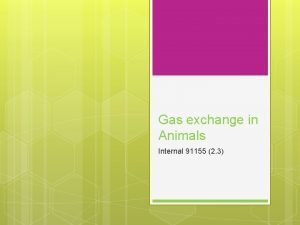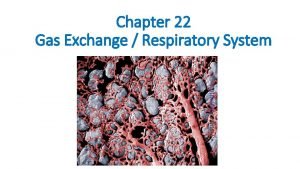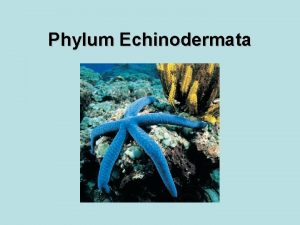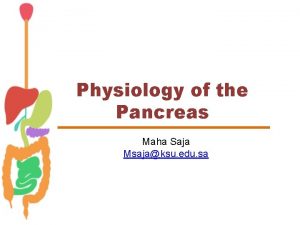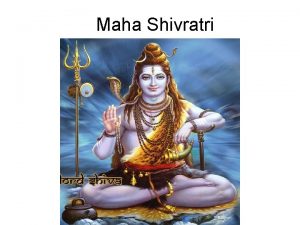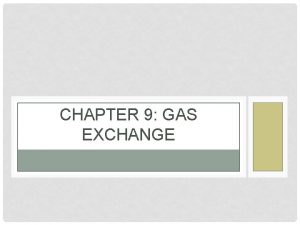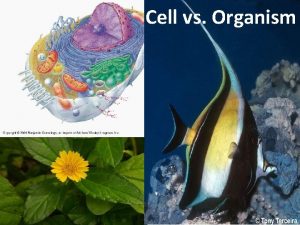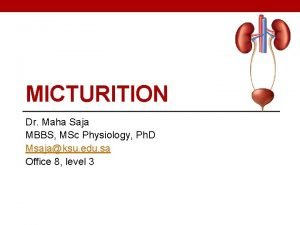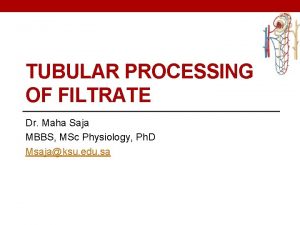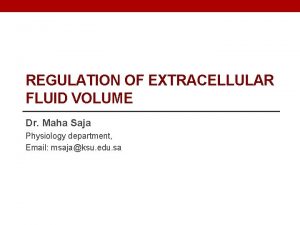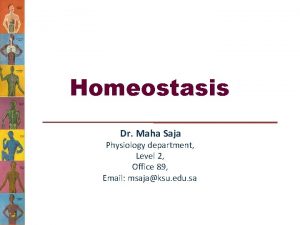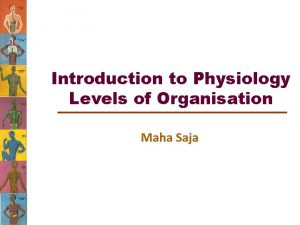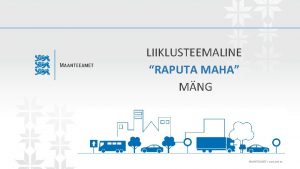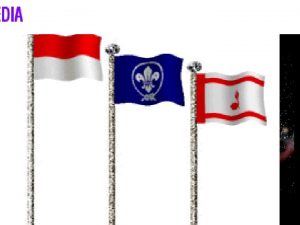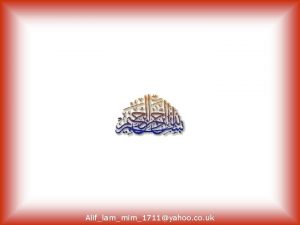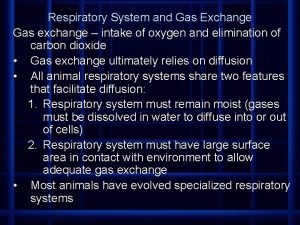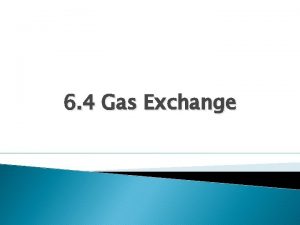LECTURE4 GAS EXCHANGE Dr Maha Saja Msajaksu edu































- Slides: 31

LECTURE-4 GAS EXCHANGE Dr. Maha Saja Msaja@ksu. edu. sa Office no. 8 level 3

Let’s summarize what have been discussed so far!

What is the aim of respiration? Remove CO 2 from tissues Deliver O 2 to tissues

Four processes help respiration achieve its goal… What are they?

1 Pulmonary ventilation Inflow & outflow of air between atmosphere & lung alveoli 2 4 Gas diffusion Movement of O 2 & CO 2 between alveoli & blood The alveolus is the gas exchange site in respiratory system Regulation 3 Gas transport Transport of O 2 & CO 2 in blood and body fluids to tissue cells

In the past 3 -4 lectures we discussed the 1 st step Pulmonary ventilation Let’s revise what we know!

Mechanism of Ventilation

Inspiration Contraction of inspiratory muscles ↑ chest volume ↓ IPP (more negative) -7. 5 cm H 2 O ↑ TPP (Palv – IPP = 0 -[-7. 5]=+7. 5 cm H 2 O) Lung (alveoli) expand (↓ Palv to -1 cm H 2 O) PB > Palv Air moves from atmosphere into the lungs

Expiration Relaxation of inspiratory muscles ↓ chest volume ↑ IPP (less negative) -5 cm H 2 O ↓ TPP (Palv – IPP = 0 -[-5]=+5 cm H 2 O) Lung (alveoli) will recoil to preinspiratory volume (↑ Palv to +1 cm H 2 O) Palv > PB Air moves out from lungs into the atmosphere

Under normal resting conditions, How much air moves in or 500 ml out of the lung during this process (ventilation)? What is it called? Tidal volume

Is the tidal volume the only volume of air that can be breathed in or out of the lungs?

What happens to the TV when it enters the respiratory passages? The volume of air occupying the conductive zone is around 150 ml This is called “Anatomical dead space”. VD VA TV = VD + VA

What happens to the TV when it enters the respiratory passages?

What are the Partial Pressures of O 2 & CO 2 in Inspired & Expired Air? •

Partial Pressures of Gases • In a gas mixture, the pressure exerted by any one gas in the mixture is equal to the total pressure of all gases in the mixture X the fractional concentration of that gas in the mixture = Partial pressure (P) • PO 2 = 760 mm. Hg X 21% ≈ 160 mm. Hg. • Can you calculate the PN 2 and PCO 2 at sea level?

What Happens to PO 2 and PCO 2 as Inspired Air Passes Through the Respiratory Tract? Atmospheric air PO 2 = 160 mm. Hg PCO 2 = 0. 3 mm. Hg Air gets humidified as it passes through the airways Humidified air PO 2 = 150 mm. Hg PCO 2 = 0. 3 mm. Hg If you know that water vapour pressure at 37⁰C is PH 2 O = 47 mm. Hg, what would happen to PO 2 and PCO 2 flowing in? The 350 ml of TV that reaches the alveoli mixes with the air present there (FRC) FRC Alveolar air PO 2 = 104 mm. Hg PCO 2 = 40 mm. Hg What are the factors affecting alveolar PO 2 and PCO 2?

Factors Affecting Alveolar PO 2 and PCO 2 1. Rate of alveolar ventilation 2. Rate of absorption of O 2 or excretion of CO 2 At rest, 250 ml of O 2 are extracted by tissues at ventilatory rate of 4. 2 L/min. At rest, 200 ml of CO 2 are excreted by tissues at ventilatory rate of 4. 2 L/min.

Summary How do you explain the readings of expired air? !!!

Gas Diffusion from alveoli into the blood

GAS EXCHANGE & GAS TRANSFER

Objectives • Define partial pressure of a gas, how is influenced by altitude. • Understand that the pressure exerted by each gas in a mixture of gases is independent of the • • • pressure exerted by the other gases (Dalton's Law) Understand that gases in a liquid diffuse from higher partial pressure to lower partial pressure (Henry’s Law) Describe the factors that determine the concentration of a gas in a liquid. Describe the components of the alveolar-capillary membrane (i. e. , what does a molecule of gas pass through). Identify the various factors determining gas transfer: Surface area, thickness, partial pressure difference, and diffusion coefficient of gas State the partial pressures of oxygen and carbon dioxide in the atmosphere, alveolar gas, at the end of the pulmonary capillary, in systemic capillaries, and at the beginning of a pulmonary capillary.

The Respiratory Unit • Respiratory bronchioles + alveolar ducts + alveoli. The site of gas exchange in the lungs. • There around 300 million alveoli in humans. • The total surface area ≈ 70 m 2 (area of a tennis court). • The blood present in the capillary bed at any time = 60 -140 ml.

The Respiratory Membrane • For gas to diffuse from alveoli to blood, it should pass through the respiratory membrane. • What is it made of? 1. 2. 3. 4. Layer of fluid. Alveolar epithelium. Epithelial BM. +/- Thin interstitial space. 5. Endothelial BM. 6. Capillary endothelial membrane. 0. 2 -0. 6 μm thick

Factors Affecting Gas Diffusion Across the Membrane •

What Determines the Partial Pressure of a Gas in a Liquid (Blood) • The solubility coefficient of different gases. What do you notice?

Diffusion of Oxygen Diffusion of O 2 from tissue capillaries to tissues Diffusion of O 2 from alveoli to pulmonary capillaries Dr. Aida Korish ( akorish@ksu. edu. sa)

Diffusion of Carbon Dioxide Diffusion of CO 2 from pulmonary capillaries to alveoli Diffusion of CO 2 from tissues to tissue capillaries Dr. Aida Korish ( akorish@ksu. edu. sa)

Dr. Aida Korish ( akorish@ksu. edu. sa)

Dr. Aida Korish ( akorish@ksu. edu. sa)

Summary Dr. Aida Korish ( akorish@ksu. edu. sa)

 Gas exchange key events in gas exchange
Gas exchange key events in gas exchange Voluntary exchange activity the pearl exchange
Voluntary exchange activity the pearl exchange Real exchange rate formula
Real exchange rate formula Edu.sharif.edu
Edu.sharif.edu Gas exchange
Gas exchange Pulmonary gas exchange and transport diagram
Pulmonary gas exchange and transport diagram Frog dissection
Frog dissection Gallant
Gallant Bioflix activity: gas exchange -- inhaling and exhaling
Bioflix activity: gas exchange -- inhaling and exhaling Capillary tissue fluid exchange diagram
Capillary tissue fluid exchange diagram Skin gas exchange
Skin gas exchange Chapter 42 circulation and gas exchange
Chapter 42 circulation and gas exchange Impaired gas exchange subjective data
Impaired gas exchange subjective data Gas exchange
Gas exchange Countercurrent exchange in fish
Countercurrent exchange in fish Air path through the respiratory system
Air path through the respiratory system How are plants adapted for gas exchange
How are plants adapted for gas exchange The actual exchange of gases occurs at the site of the
The actual exchange of gases occurs at the site of the Examples of sponges invertebrates
Examples of sponges invertebrates Echinoderms have spiny skin
Echinoderms have spiny skin Gas exchange in plants and animals venn diagram
Gas exchange in plants and animals venn diagram Egrette ch 22
Egrette ch 22 Holothuroidea
Holothuroidea Poisonous gas leaked in bhopal gas tragedy
Poisonous gas leaked in bhopal gas tragedy Gas leaked in bhopal gas tragedy
Gas leaked in bhopal gas tragedy Gas law
Gas law Difference between ideal gas and real gas
Difference between ideal gas and real gas Gas reale e gas ideale
Gas reale e gas ideale Ideal gas vs perfect gas
Ideal gas vs perfect gas Kinetika kimia
Kinetika kimia Ideal gas vs perfect gas
Ideal gas vs perfect gas Bhopal gas tragedy reason
Bhopal gas tragedy reason




